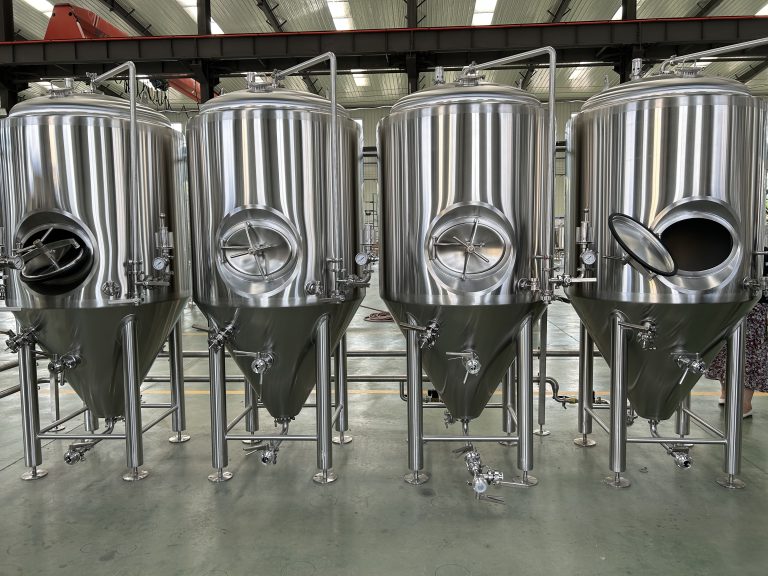



A 300L beer brewing equipment system is designed for small-scale brewing, producing up to 300 liters of beer per batch. This type of equipment is ideal for craft breweries, brewpubs, or for experimental and pilot batches.
1.Introduction for 300L Mini Beer Brewing Equipment:
300L turnkey mini beer brewing equipment is a relatively small-scale setup,this size is ideal for small-scale breweries, pilot projects, or brewpubs.
2.300L Mini Beer Brewing Equipment Specification:
| Output/Brew | 300L |
| Brew/Week | 2~6 |
| Output/Week | 600~1800L |
| Electric Supply | 3phase/380(208, 415,480…)v/50 (60)Hz |
| Heating Source | Electric/Steam |
| Area Request | 30m2-40m2 |
| Brewmaster | 1 |
3.300L Turnkey Mini Beer Brewing Equipment Configuration:
| General specification for 300L brewing equipment | ||||
| No. | Name | Components | Capacity | Specification |
| 1 | Grain Milling Unit | Rolling Miller | 80~150kg/hr | Double roller |
| Power:1.1Kw | ||||
| Noise:45±3db | ||||
| 2 | Brewhouse Unit | Mash/Lauter tun | 300L | Side mounted grain outdoor with grain chute |
| Laser cutting V-wire False Bottom | ||||
| Kettle/Whirlpool Tun | 300L | Electric heating; Power: 18kw | ||
| Tangential whirlpool inlet | ||||
| Sanitary leveling sight glass | ||||
| Heat exchanger | 4M2(Effective area) | Completely 304 SS Corrugated plates | ||
| LYSF pump | 3M3 | ABB, Sanitary SUS304, VFD control | ||
| Pipe and fittings | As design | completely SS304 | ||
| 3 | Fermentation unit | Fermenter | 300L or 600L | Dimple cooling jacket on cone and bottom |
| Top manway or side manway | ||||
| 60 degree cone bottom | ||||
| Perlick style full sanitary sampling valve | ||||
| Carbonation port and level tube for special request | ||||
| 4 | Bright beer tank | Bright beer tank | 300L or 600L | Dimple cooling jacket on cone and bottom |
| Level tube for checking | ||||
| Top manway or side manway | ||||
| Perlick style full sanitary sampling valve | ||||
| Carbonation port with tri clmap carbonation stone | ||||
| 6 | Glycol Chilling Unit | Glycol Water Tank | 8HL | Insulated conical top and sloped bottom |
| Chiller | 5HP | Cooling Capacity: 11000Kcal/5HP | ||
| Installed Power:5.5kw | ||||
| Noise:70-80db | ||||
| Refrigerant: Freon R404A ,R410A | ||||
| Coperland compressor | ||||
| PVC pipe | As designed | Solenoid valves for glycol inlet to tanks are included | ||
| Glycol water pump | 3M3 | Sanitary SUS304, VFD control | ||
| 7 | Control unit | Brewhouse and fermentation
process Controlling |
Floor type | Manual button control panel or PLC control with touch screen for special |
| 8 | CIP | CIP pump with VFD | 3M3 | LYSF, VFD control |
| 9 | Keg cleaning | single head | 20-30kegs/hr | Heating: Electric, Power: 15kw |
| 10 | Keg filling | A coupler | Manual | Coupler for filling beer |
| 11 | Bottling line | 4 head | 160-180 bottles/hr | Manual |
| 12 | Others | Option | Can be Customized | Auger System |
| Grain Case | ||||
| Grist Hydrator | ||||
| Piping flow panel for Brewhouse | ||||
4.Advantages of a 300L mini beer brewing equipment:
Cost-Efficiency: mini brewing equipment, like a 300L system, offers a more cost-effective entry point into the brewing industry compared to larger commercial setups. It requires less initial investment in equipment, space, and resources.
Space Optimization: It’s smaller and requires less space compared to larger brewery systems, making it suitable for smaller locations or areas with limited space availability. This allows for more flexible placement and operational adaptability.
Flexibility and Experimentation: The smaller batch sizes allow for more experimentation with recipes, ingredients, and brewing techniques. Brewers can test and refine their craft without committing to large volumes, fostering innovation and creativity.
Adaptability and Scalability: Nano breweries have the flexibility to adapt quickly to changing market trends and consumer preferences. If demand grows, they can often scale up gradually by adding more fermenters or expanding equipment.
5.What factors should be considerations about 300L mini beer brewing equipment:
Space Requirements: Assess the available space for brewing equipment, fermentation vessels, storage, and operational workflows. Ensure the space is sufficient and adaptable for the brewing setup.
Budget and Costs: Calculate the total investment required for equipment, installation, utilities, ingredients, permits, and ongoing operational expenses. Understand the financial implications before starting the brewery.
Workflow and Efficiency: Understand the brewing process and the workflow of the equipment. Optimize the layout and operations to ensure efficiency and consistent quality across batches.
Licensing and Permits: Research and comply with local, state, and national regulations, including health and safety standards, environmental regulations, and alcohol production licenses.
Growth Plans: Plan for potential business growth and whether the equipment can support increased production demands.
Support and Warranty: Consider the level of customer support, training, and warranty offered from supplier.
Conclusion:
A 300L mini beer brewing equipment offers a platform for passionate brewers to experiment, create unique flavors, and potentially grow into a larger-scale operation. However, it requires careful planning, dedication, and a focus on quality to succeed in the competitive craft beer industry.